
15 Angeleno-approved alternatives to L.A.’s usual tourist spots
- Share via
So a loved one is in town and wants to explore Los Angeles like a rookie.
Perhaps your brother needs to visit the In-N-Out closest to LAX instead of the far less obnoxious location in your neighborhood. Or your childhood friend wants to take a movie studio tour in 95-degree weather. Maybe your mom — bless her heart — is forcing you to drive across the city during rush hour just to learn firsthand that there’s never any parking at Griffith Observatory in the hour before sunset.
Planning your weekend?
Stay up to date on the best things to do, see and eat in L.A.
All Angelenos have been there before, and though some memories are worth braving the hassles that come with a visit to the most well-known spots in town, we still can strive to make our lives easier. Thankfully, L.A. is massive, which means that there are plenty of ways to enjoy local wonders with thinner crowds and better parking.
If a friend is dying to set foot on the Hollywood Walk of Fame, sure, fine, oblige. We’re not discounting any of these popular spots — many attract hordes of tourists for good reason. But if your visitors are open to following your lead, consider guiding them to one of these 15 alternative (yet completely worthwhile) activities that are slightly less traveled.
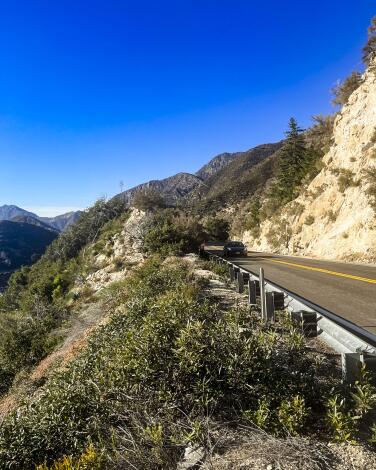
Instead of PCH, cruise down Angeles Crest Highway
Thankfully, there’s another scenic route through the region’s natural beauty — and it’s equally compatible with a convertible. Starting in the northern L.A. County suburb of La Cañada Flintridge, the two-lane Angeles Crest Highway — a portion of State Route 2 — snakes high up into the San Gabriel Mountains and Angeles National Forest. In lieu of an ocean breeze, motorists are treated to woodsy vistas and sweeping views of the metropolis below at every hairpin turn.
A major stretch of the highway recently reopened after a months-long closure, making it an opportune time to explore a wealth of freshly accessible vistas. (Some areas are still undergoing repairs from fierce winter storms, so check the latest updates before you head out.)
If you’d like to make a day of the excursion, pull over and scope out one of the many trails etched into the mountains — or turn off at Red Box junction and head up to historic Mt. Wilson Observatory. For a strenuous hike, try Strawberry Peak Trailhead, where you can triumphantly top out at a nearly 6,200-foot summit. When closures don’t block access, you can drive the entire 66-mile length of the highway into Wrightwood, a quaint mountain town that’s worth a pit stop to lap up some ice cream and small-town charm.
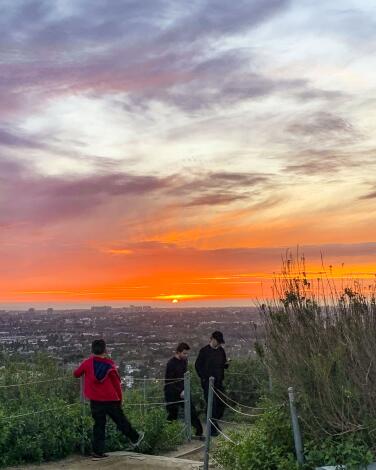
Instead of Griffith Park, watch the sunset at Baldwin Hills Scenic Overlook
Instead, you can drive over to the Baldwin Hills Scenic Overlook, where there’s a fairly roomy parking lot at the top of the hill that costs $2 an hour (or $6 for the whole day). From the lot, you can walk about five minutes to a giant concrete platform that sits atop the 282-step Culver City stairs. There you’ll find a sweeping view of Los Angeles that spans the ocean, downtown L.A., the Hollywood sign and even Griffith Observatory. The overlook also has paths that wind around the top of the hill, so you can snag a bench facing whichever direction you’re enjoying the most.
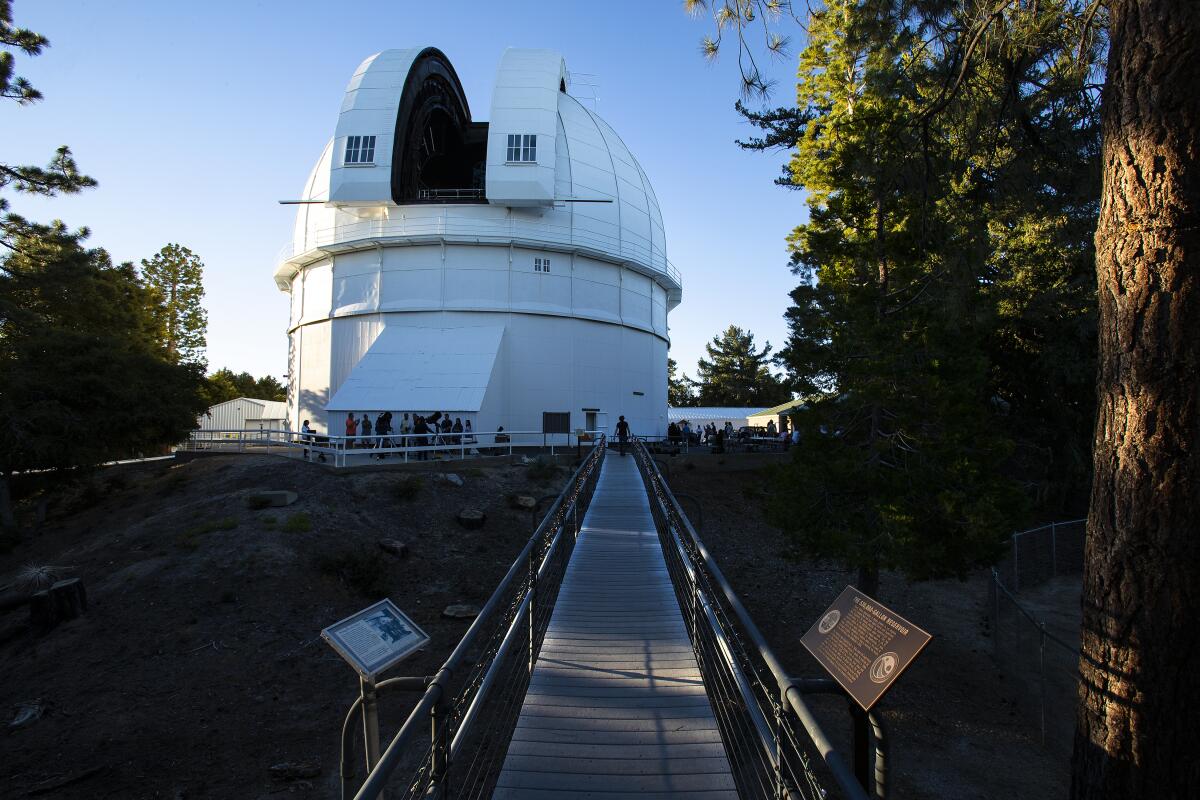
Instead of Griffith Observatory, see the stars at Mt. Wilson Observatory
Mt. Wilson Observatory, perched high on a peak in the San Gabriel Mountains, stands as another vintage testament to Los Angeles’ once-dark skies — before the city lights drowned out the starlight. Accessible by way of a winding road off the Angeles Crest Highway, it still feels worlds away from the bustling megapolis below.
Unlike Griffith, the observatory above Pasadena doesn’t offer panoramic views of the Hollywood sign and can’t say James Dean graced the grounds for a film shoot. But the nearly 120-year-old institution holds a scientific claim to fame: A century ago, astronomer Edwin Hubble gazed through the observatory’s Hooker 100-inch telescope and spied celestial phenomena he would use to prove that we’re not alone in the universe. Our galaxy is just one of many in an expanding space.
The prodigious telescope that enabled Hubble’s and other luminaries’ universe-altering discoveries marked an engineering feat when it was completed in 1917, becoming the world’s largest telescope until 1949. More than 100 years later, it’s still the observatory’s biggest draw.
On some ticketed nights (sadly sold out for 2023), members of the public can peer through the hulking instrument into our celestial backyard. Every day from 10 a.m. to 5 p.m., visitors are welcome to observe the telescope from a viewing window housed in a white dome on the woodsy campus. Nearby is the rudimentary but charming one-room Astronomical Museum, which provides an overview of the observatory’s beginnings and notable scientific achievements.
If you want to make a day of it, take advantage of one of the many hikes that crisscross the mountain. Pro tip: At 5,715 feet, the observatory is elevated enough to offer a cool respite when temperatures soar below. In winter, it can snow.
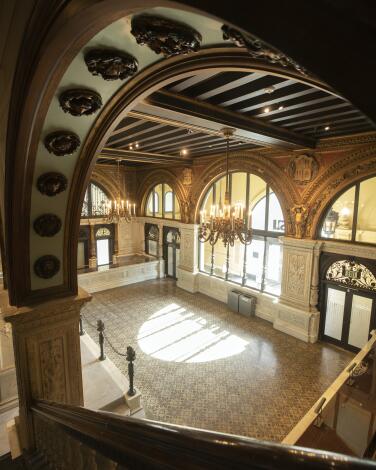
Instead of the Annenberg Community Beach House, marvel at Julia Morgan’s Herald Examiner building
Located on the corner of Broadway and 11th streets, the building was boarded up and in disrepair after the newspaper shut down in 1989. Today, it is used as a learning center for Arizona State University following an extensive remodel. Sadly, you can’t just walk inside and tour the interiors and stunning lobby, but you can still enjoy the Mission Revival building from the street, with its impressive Moorish, Spanish, and Italian touches and cupolas covered in yellow and blue tile. The public can arrange tours by contacting ASU’s Elizabeth Tam at [email protected].
(Publisher William Randolph Hearst commissioned Morgan, California’s first licensed female architect, to design the headquarters for his Los Angeles Examiner newspaper in 1913 and was so pleased with her work that he hired her to design her most famous project, Hearst Castle, five years later).
This stretch of Broadway is great for an architectural walking tour, and you’ll find plenty of shopping (Urban Outfitters, West Elm, PacSun, Paul Smith), chic boutique hotels (Hoxton, Proper, Ace) and restaurants (Caldo Verde, Zinque, LOAM, Tacos Mexico) along the way. Travel three blocks north to Eighth and Broadway — past the Spanish Gothic Ace Hotel and theater and the Art Deco Eastern Columbia Building and you’ll find the Baroque Revival style Tower Theatre Apple Store, which, like the Herald Examiner, was once abandoned and now has been reborn. Go inside the former movie palace, even if you’re not interested in purchasing something from the store. It is filled with opulent details that are well worth your time, including a grand lobby inspired by Charles Garnier’s Paris Opera House, ornate crystal chandeliers, a restored stained-glass window in a fleur-de-lis pattern and, perhaps most arresting, ceiling murals depicting clouds in skies of blue.
Many metered parking spaces and multiple parking lots are nearby if you want to park and walk. But be careful when you read the signs at independent lots because they can be misleading about prices.
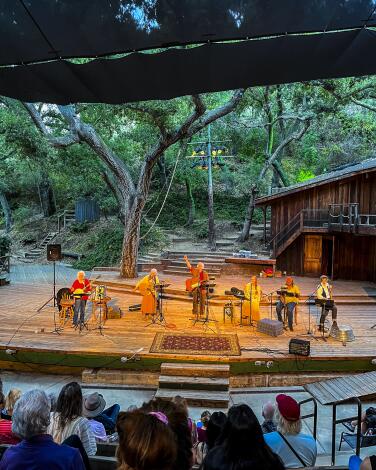
Instead of the Hollywood Bowl, catch a show at the Will Geer Theatricum Botanicum
The open-air theater is tucked into Topanga Canyon, the stage and seats laid out in a forest, with a big screen above to catch acorns and make shade.
Though Will Geer is best known nationally for playing the grandfather in “The Waltons” from 1972 until his death in 1978, his acting career spanned four decades. Along the way he made his mark as a labor organizer and dissident (blacklisted in the 1950s) and a longtime friend of Woody Guthrie (1912-67).
In the early 1950s, Geer and his wife, Herta Ware, bought the Topanga property. Geer, who had a botany degree from the University of Chicago, planted extensive gardens and invited other blacklisted writers and performers to entertain each other. Guthrie briefly lived in a shack that theatergoers pass on the way to their seats.
“They did Shakespeare in the dirt,” said Theatricum office manager Gina Shansey. “For free. It was a pass-the-hat type situation.”
The Theatricum mainstage, now much upgraded but still rustic, seats 299 people. The theater company, born formally in the 1970s, runs a summer season that usually includes multiple works by Shakespeare plus at least one other work and closes with a night of songs and stories about Woody Guthrie or Pete Seeger (in alternating years). It’s largely a family operation, led by producing artistic director Ellen Geer (Will’s daughter), and associate artistic director Willow Geer (Ellen’s daughter).
The season usually runs early June to early October and Theatricum also stages improv comedy and occasional concerts (in summer), a one-night winter holiday event and educational programming. Adult admission to the plays is usually $30 to $40.
Seating is on wooden benches; be sure to grab one of the cushions that staffers offer as audiences enter. It’s also wise to bring mosquito repellent.
Guests are invited to bring picnics to share on the 14-acre grounds, which include many chairs, tables and fountains; an outlet selling snacks and drinks (the Hamlet Hut); a bust of Will Geer; and, beneath the earth, his and Herta’s ashes. Most visitors park in the theater’s dirt lot for $10 or along Topanga Canyon Boulevard.

Instead of Pink's, grab a hot dog at Tail o’ the Pup
You’ll also find a kid-friendly “puppy” dog that comes in a puppy-shaped bun, a doggy menu, corn dogs, cheeseburgers, French fries, onion rings, milkshakes, soft serve and plenty of hot dog add-ons, including chili. You’ll pick up your selections from the counter inside, but I suggest enjoying them in the classic diner-inspired environment with a row of yellow bar stools overlooking street traffic and a second-story covered patio.
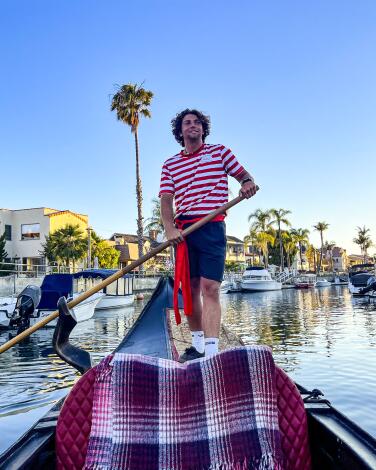
Instead of the Venice Canals, paddle around the Naples Canals
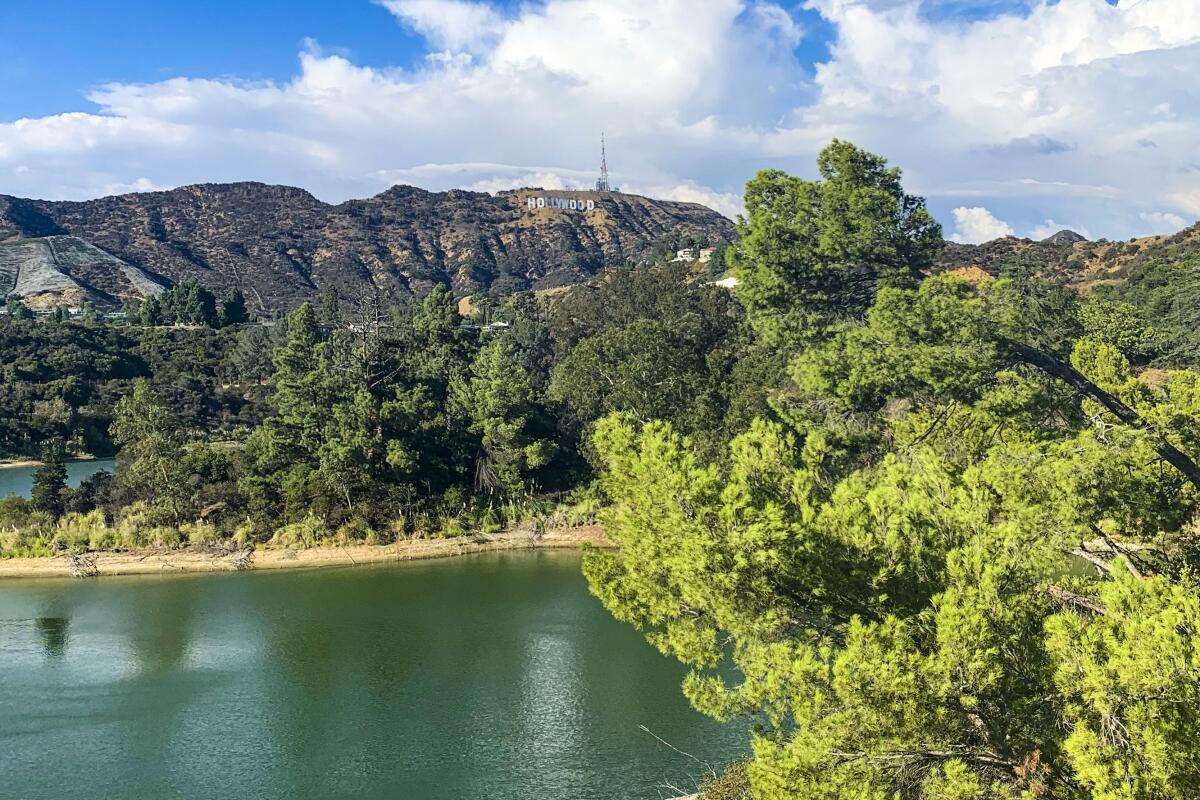
Instead of hiking to the Hollywood sign, see it from the Hollywood Reservoir
Some people prefer to snap photos on the other side of the reservoir and Upper Hollywood Reservoir, near the Mulholland Dam and Lake Hollywood Park, but street parking there is far more competitive.
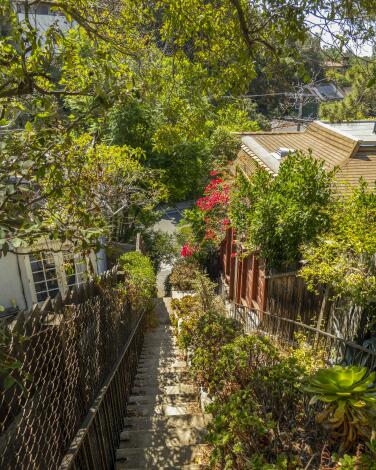
Or instead of Mulholland Highway, see the Hollywood sign from the Beachwood Canyon stairs walk
I’ve detailed the walk, step by step, in my guide to L.A.’s hardest staircases. Find full walking directions there. A couple of important notes before you start: We took this walk on a Sunday, when there was far too much traffic and too many people walking up the hill to see the sign. If possible, try to schedule this walk on a weekday, when the crowds will be thinner, and stop in at the excellent Beachwood Cafe for a delicious meal (open daily 9 a.m. to 9 p.m. except Mondays, when it’s open 4 to 9 p.m.). On Sunday, the wait was way too long for two ravenous walkers.
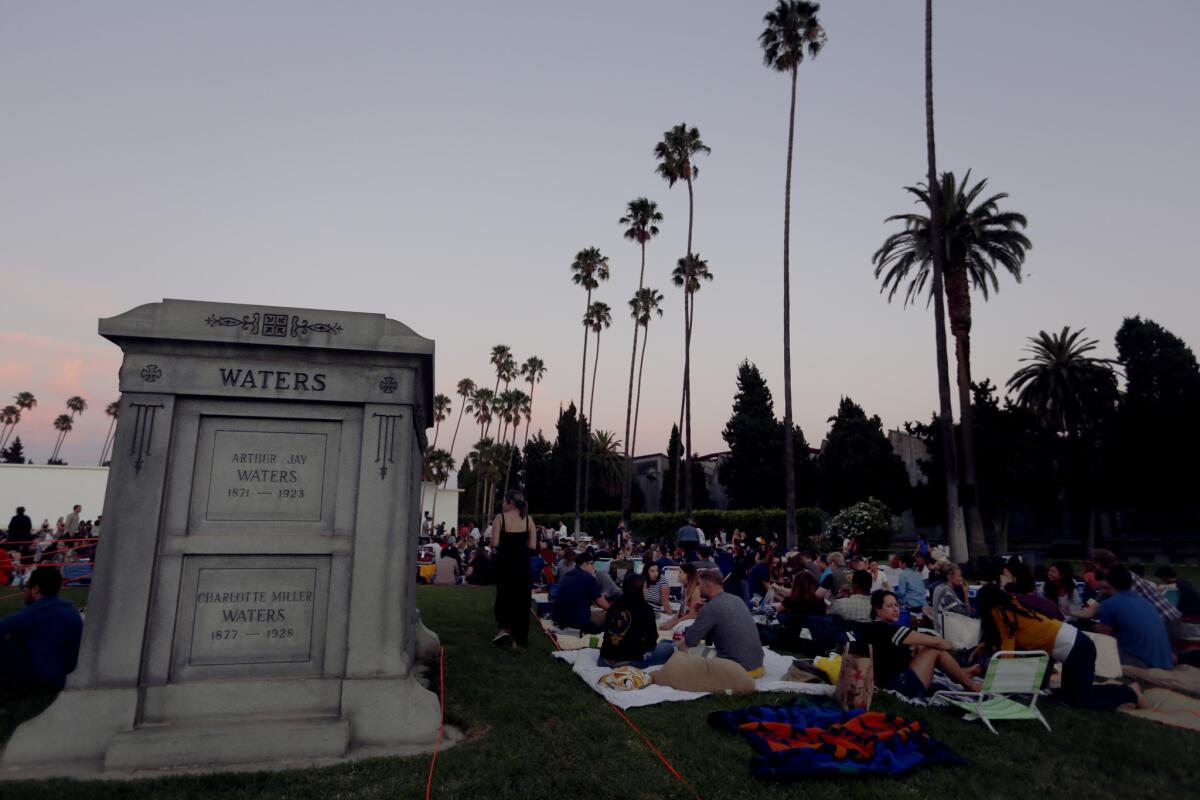
Instead of TCL Chinese Theatre (and the Hollywood Walk of Fame), watch a movie at Hollywood Forever Cemetery
For those who want to spend a more interesting night among Hollywood’s stars, Cinespia plans dozens of movies in Hollywood Forever Cemetery every summer. Some of the stars are literally there — Hollywood Forever is the final resting place for lots of celebrities, including Judy Garland and Mickey Rooney. The cemetery has been a backdrop in shows and movies such as “Insecure” and “Under the Silver Lake” (2018) as well as music performances by Lana Del Rey, Big Thief and others.
Past screenings have included “Gremlins” (1984), “Showgirls” (1995) and the more recent “A Star Is Born” (2018), and they run from May through September (though there are sometimes special Halloween screenings). Attendees are welcome to bring a picnic, beer and wine, though food and drinks are available for purchase. Parking passes are sold online through Cinespia, which can make the night a bit smoother, and I’d recommend bringing a blanket and some low chairs or pillows for comfort.
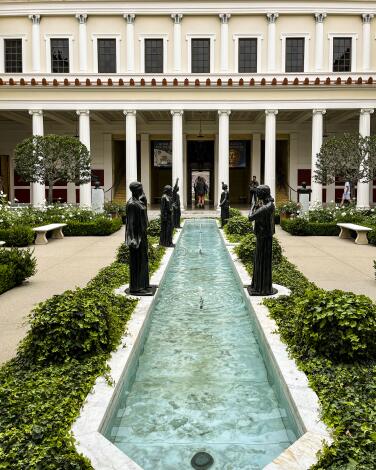
Instead of the Getty Center, see Greek and Roman art at the Getty Villa
But if you have visitors who want to check out Malibu or an adjacent beach, the Getty Villa can be a great way to optimize your day.
While the Getty Center is in a fairly isolated spot along the 405, the villa sits along Pacific Coast Highway in Pacific Palisades, sandwiched right between Topanga and Santa Monica. The villa is a meticulous re-creation of an ancient Roman country house, with picturesque fountains, a herb garden and two peristyles, making it the perfect spot to bring any art history geeks or aspiring influencers in your life. It has a smaller collection than the Getty Center, but the villa’s assortment of ancient Greek, Roman and Etruscan art makes it perfect for a quick stop on a packed itinerary. Once you leave the Getty Villa, it’s worth driving a few minutes up to the Reel Inn Malibu for some fresh fish and cheap drinks.
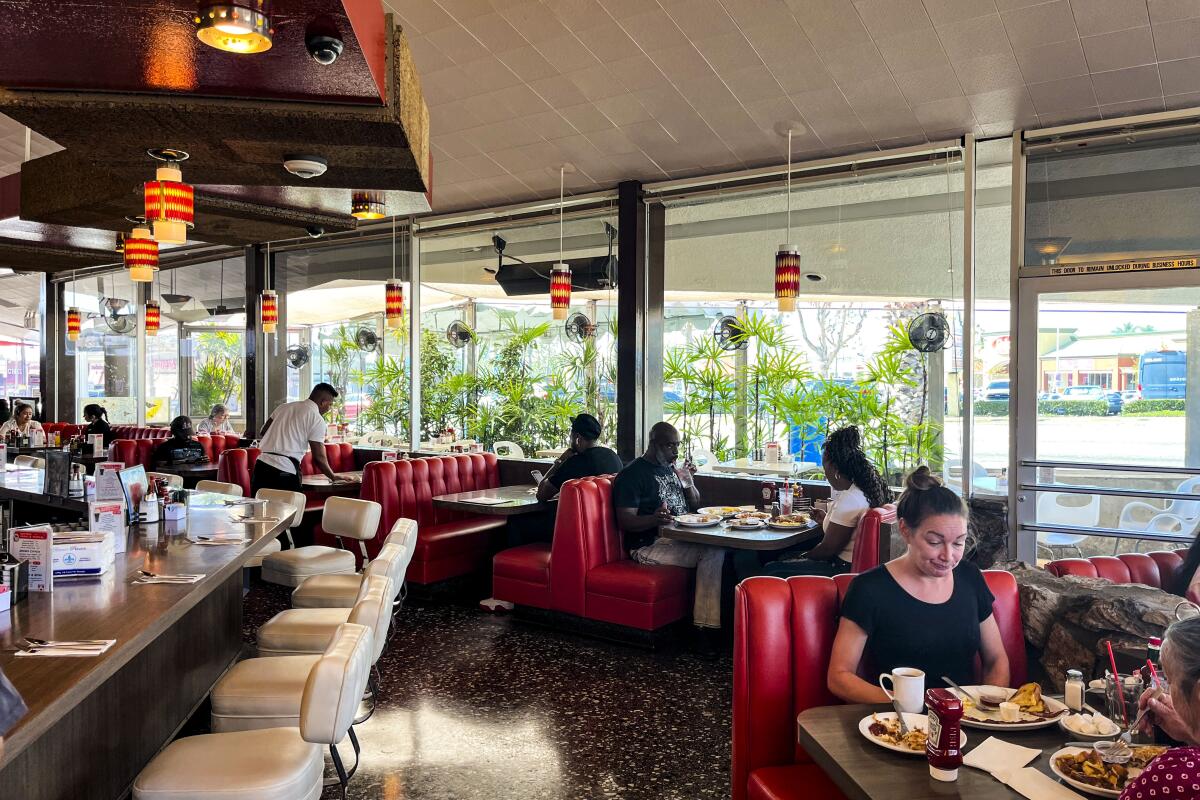
Instead of Swingers, sip a mimosa at Pann's
If you’re looking for a retro diner that serves up delicious comfort meals and has Hollywood appeal, head over to Pann’s in Westchester instead. Open since 1958, Pann’s is known for its hotcake plates — you can choose waffles, French toast or pancakes — that come with one side and one protein (including options like bacon, a pork chop, fiery beef link and fried chicken wings) for $18.95, as well as the mouthwatering Dreamburger (starts at $10.55). At $5.95, the mimosas — flavor options include orange, cranberry, mango, strawberry, peach or guava — may be among the most affordable options in Los Angeles. (Mimosas are $7.95 at Swingers.)
Pann’s red leather booths and long line of barstools have also served as the backdrop for several TV shows and films, including Issa Rae’s “Insecure” and the 2005 “Bewitched.” And no one blinks an eye when social media influencers take photos inside the diner while posing with one of Pann’s tasty milkshakes (chocolate, vanilla or strawberry). The best part, though, is that the restaurant is less than five miles from LAX, making it a perfect pit stop for a bite either before or after flying out of the airport.
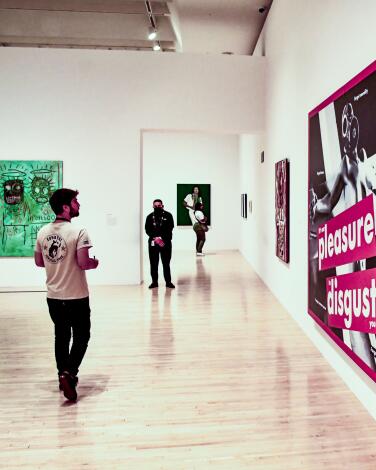
Instead of the Broad, wander around the Museum of Contemporary Art
But wait. The Museum of Contempory Art, a pioneer in the push to make Grand Avenue a cultural corridor, is just across the street and a block away.
If you’d like some quiet time with Jackson Pollock, Alexis Smith, Patssi Valdez, Cy Twombly and other big names and bold innovators in art since 1940, MOCA can deliver it. Like the Broad, it’s free (so long as you book time-specific admission online in advance). It covers a lot of the same artistic territory. It has a good-sized shop. And you probably won’t have to stand in line.
I revisited on a recent weekday and found the galleries splendidly uncrowded, except for a couple of school groups. Wrangled closely by museum staffers, the kids carried folding stools from room to room, wrestling with the idea (as demonstrated on every side) that art can be almost anything.
All of MOCA’s art is on one level. Among the portraits, assemblages, photos, videos, sculptures and abstract paintings in MOCA, you see a lot of limits being tested.
Much of the Grand Avenue space is dominated by the museum’s permanent collection, as represented through May 5 by “Long Story Short,” a survey of art since the 1940s drawn from the 7,500 pieces the museum owns. One of my favorites: the big black and blue blob by Mark Rothko.
Through March 10, the museum also is featuring “Mapping an Art World: Los Angeles in the 1970s-’80s,” which is when MOCA came to life. The show highlights more than 200 artworks and pieces of ephemera, including works by Eleanor Antin, John Baldessari, Mike Kelley, Claes Oldenburg and Ed Ruscha, along with photos by Joe Deal of the MOCA building, designed by Arata Isozaki, going up from 1984 to 1986.
MOCA (which also runs the Geffen Contemporary space on Central Avenue) closes on Monday. It’s open from 11 a.m. to 5 p.m. on weekdays except Thursday (when it stays open until 8 p.m.); and 11 a.m. to 6 p.m. on weekends.
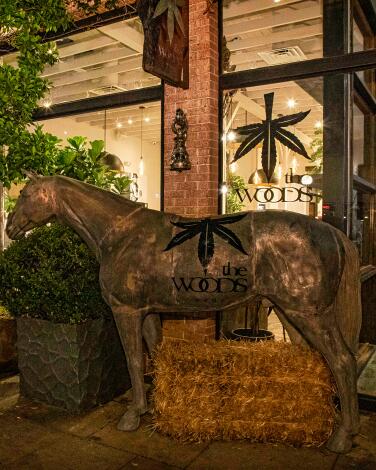
Instead of the sidewalk outside MedMen, light a joint at the Woods
The best of the bunch is probably the Woods — for several reasons. First, it’s got serious celebrity cachet (among those with an ownership stake are Bill Maher, John McEnroe and herbal advocate Woody Harrelson, who has been known to say hello to folks when he’s on property). Second, right behind the pot shop is the Ganja Giggle Garden, a leafy green oasis filled with Buddha statues, cat-sized koi and stylishly appointed cannabis-consumption cabanas that can be reserved for your puffing pleasure (as well a a communal space for the spur-of-the-moment pop-in sesh to unfold). Third, and most important, are the products on the dispensary shelves, a bumper crop of California’s craft cannabis (including outdoor, sungrown weed, product from legacy farmers and herb grown in comparable-to-organic conditions) from brands like Sol Spirit, Huckleberry Hill Farms and No Till Kings as well as a deep bench of L.A.-area favorites like Pure Beauty (look for the brand’s 10-packs of “babies” — 0.35-gram mini-joints for on-the-go sightseers) and Papa & Barkley tinctures and topicals.
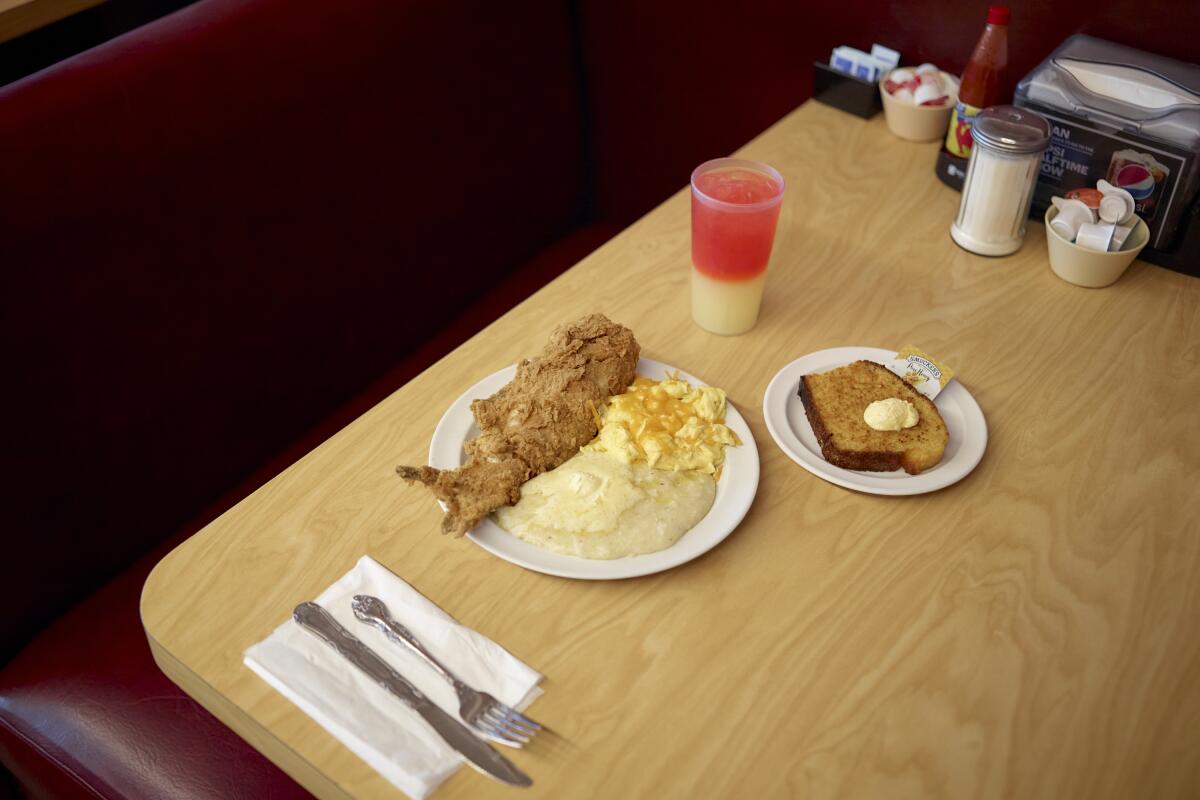
Instead of Roscoe's, have fried chicken and waffles at the Serving Spoon
Here, you’ll find menu items that overlap with Roscoe’s at super-affordable prices, including fluffy pancakes, cinnamon-dusted waffles and plush French toast that can be paired with ham, bacon, Polish sausage, salmon, rib-eye steak and, yes, fried chicken. Grits, home-style potatoes and oatmeal all vie as potential side items, and the breakfast burrito competes with some of the city’s best. Lunch adds dishes such as salmon croquettes, catfish nuggets, pork chops, burgers, sandwiches and sides like collard greens, mac and cheese, candied yams and red beans and rice.
The Serving Spoon does takeout, but dine in if you can. Like Roscoe’s, the service is warm and the dining room is filled with homey touches, including photos of the owners with celebrity clientele such as Whoopi Goldberg and Eddie Murphy.
Sign up for This Evening's Big Stories
Catch up on the day with the 7 biggest L.A. Times stories in your inbox every weekday evening.
You may occasionally receive promotional content from the Los Angeles Times.



